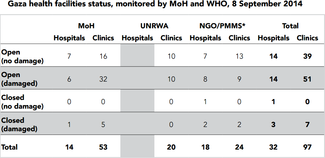On 12 June, three Israeli youths were abducted and later killed on their way home from a religious school (yeshiva) in two Israeli settlements in the southern West Bank. The Israeli authorities held Hamas responsible and identified three Hamas activists as the perpetrators; one of them was subsequently arrested.
The Monthly Humanitarian Bulletin | June - August 2014
In this document
During the 50-day Gaza emergency, 75 health structures (17 hospitals and 58 clinics) were damaged to varying degrees and 44 facilities were closed at one time due to damage or for security reasons, limiting access to health services to almost half of the population. Nevertheless, following the ceasefire, only four of the 32 hospitals monitored by the Ministry of Health (MoH) and WHO remain closed.
On 25 August, the Israeli Civil Administration (ICA) announced the declaration of 3,799 dunums of land (1 dunum = 1000 m2) in Bethlehem governorate as ‘state land’. This follows a case earlier this year, on 6 April 2014, in which the ICA had declared 1,000 dunums of land in Area C, also in Bethlehem governorate, to be ‘state land’. According to the Israeli media, this measure was approved by the Israeli cabinet in response to the kidnapping and killing of three Israeli youths in June.
In early September, the Humanitarian Country Team (HCT) launched its Gaza Crisis Appeal outlining the joint strategy of the humanitarian community, including UNRWA, to respond to the current crisis in the Gaza Strip. The appeal requests $551 million to carry out 108 projects, implemented by 54 partners, including 13 UN agencies.
The hostilities that took place between 7 July and 26 August 2014 can be broken down into three phases: a period of air, land and naval strikes between 7 and 17 July; a ground operation by Israeli forces entering the Gaza Strip from 18 July to 5 August, accompanied by continuing airstrikes; and a period of alternating ceasefires and military strikes until an indefinite ceasefire came into effect on 26 August.
The extensive Israeli aerial bombardment, naval shelling and artillery fire had devastating results on public infrastructure, including water, sanitation and energy. Although infrastructure had been repeatedly hit during previous escalations, the damage on this occasion was unprecedented. Already extremely fragile prior to the hostilities, the damage to the water and energy infrastructure further undermined access to basic services and sources of livelihood.
During the reporting period, the Israeli authorities demolished a total of 82 Palestinian-owned structures across the West Bank, displacing nearly 200 people, 60 per cent of them children, and otherwise negatively affecting another 300. Although demolitions were fewer in number than during the beginning of the year and the equivalent period in 2013, the resumption of punitive and ‘military’ demolitions, and the advancement of a plan to ‘relocate’ entire Bedouin communities in Area C, were worrying developments.
The response of national authorities during the hostilities was severely constrained by the long-standing movement and access restrictions imposed on Gaza, as well as internal Palestinian divisions. The rapidly deteriorating humanitarian situation since July 2013 had depleted people’s coping mechanisms and weakened the preparedness of the authorities to respond to emergencies. Humanitarian actors also noted gaps in preparedness and stock shortages, mainly due to a lack of funding in certain critical sectors and entry challenges for so-called dual use items.

















